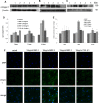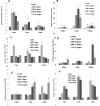BMP-2 Is Involved in Scleral Remodeling in Myopia Development
- PMID: 25965995
- PMCID: PMC4429026
- DOI: 10.1371/journal.pone.0125219
BMP-2 Is Involved in Scleral Remodeling in Myopia Development
Abstract
The development of myopia is associated with scleral remodeling, but it is unclear which factors regulate this process. This study investigated bone morphogenetic protein-2 (BMP-2) expression in the sclera of guinea pigs with lens-induced myopia (LIM) and after recovery from myopia and evaluated the effect of BMP-2 on extracellular matrix (ECM) synthesis in human scleral fibroblasts (HSFs) cultured in vitro. Lens-induced myopia was brought about in two groups of guinea pigs (the lens-induced myopia and myopia recovery groups) by placing -4.00 D lenses on the right eye for three weeks. The left eye served as a contralateral control. In the recovery group, the lenses were removed after one week. The refractive power and axial length of the eyes were measured, and the BMP-2 expression levels in the sclera were measured. After three weeks, the lens-induced eyes acquired relative myopia in both groups of guinea pigs. Immunostaining of the eyeballs revealed significantly decreased BMP-2 expression in the posterior sclera of the myopic eyes compared to the contralateral eyes. One week after lens removal, BMP-2 expression recovered, and no differences were observed between the experimental and contralateral eyes in the recovery group. HSFs were cultured with BMP-2 or transforming growth factor-β1 (TGF-β1). Type I and type III collagen synthesis was significantly up-regulated following BMP-2 treatment in culture after one and two weeks, but the ratio of type III to type I collagen mRNA was not increased. Biosynthesis of glycosaminoglycan (GAG) and aggrecan was increased in HSFs treated with BMP-2. Some chondrogenesis-associated genes expression increased in HSFs treated with BMP-2. From this study, we concluded that BMP-2 is involved in scleral remodeling in the development and recovery of lens-induced myopia.
Conflict of interest statement
Figures







Similar articles
-
Retinal and choroidal expression of BMP-2 in lens-induced myopia and recovery from myopia in guinea pigs.Mol Med Rep. 2016 Mar;13(3):2671-6. doi: 10.3892/mmr.2016.4843. Epub 2016 Feb 2. Mol Med Rep. 2016. PMID: 26847492
-
Alterations in protein expression in tree shrew sclera during development of lens-induced myopia and recovery.Invest Ophthalmol Vis Sci. 2012 Jan 25;53(1):322-36. doi: 10.1167/iovs.11-8354. Invest Ophthalmol Vis Sci. 2012. PMID: 22039233 Free PMC article.
-
Scleral gene expression during recovery from myopia compared with expression during myopia development in tree shrew.Mol Vis. 2014 Dec 9;20:1643-59. eCollection 2014. Mol Vis. 2014. PMID: 25540576 Free PMC article.
-
The sclera and myopia.Exp Eye Res. 2006 Feb;82(2):185-200. doi: 10.1016/j.exer.2005.08.009. Epub 2005 Oct 3. Exp Eye Res. 2006. PMID: 16202407 Review.
-
Role of the sclera in the development and pathological complications of myopia.Prog Retin Eye Res. 2003 May;22(3):307-38. doi: 10.1016/s1350-9462(02)00063-0. Prog Retin Eye Res. 2003. PMID: 12852489 Review.
Cited by
-
RNA sequence analysis identified bone morphogenetic protein-2 (BMP2) as a biomarker underlying form deprivation myopia.Biochem Biophys Rep. 2022 Apr 18;30:101261. doi: 10.1016/j.bbrep.2022.101261. eCollection 2022 Jul. Biochem Biophys Rep. 2022. PMID: 35494490 Free PMC article.
-
Interleukin-6 and Interleukin-8 Gene Expressions Differ Between Male and Female Patients at Time of Hip Arthroscopy for Femoroacetabular Impingement Syndrome.Arthrosc Sports Med Rehabil. 2024 Jul 30;6(6):100985. doi: 10.1016/j.asmr.2024.100985. eCollection 2024 Dec. Arthrosc Sports Med Rehabil. 2024. PMID: 39776506 Free PMC article.
-
Decreased choroidal and scleral thicknesses in highly myopic eyes with posterior staphyloma.Sci Rep. 2021 Apr 12;11(1):7987. doi: 10.1038/s41598-021-87065-6. Sci Rep. 2021. PMID: 33846467 Free PMC article.
-
Identifying pathological myopia associated genes with GenePlexus in protein-protein interaction network.Front Genet. 2025 Mar 5;16:1533567. doi: 10.3389/fgene.2025.1533567. eCollection 2025. Front Genet. 2025. PMID: 40110040 Free PMC article.
-
Advances in myopia research anatomical findings in highly myopic eyes.Eye Vis (Lond). 2020 Sep 2;7:45. doi: 10.1186/s40662-020-00210-6. eCollection 2020. Eye Vis (Lond). 2020. PMID: 32905133 Free PMC article. Review.
References
-
- Lin LL, Shih YF, Tsai CB, Chen CJ, Lee LA, Hung PT, et al. Epidemiologic study of ocular refraction among schoolchildren in Taiwan in 1995. 1999; Optom Vis Sci 76: 275–281. - PubMed
-
- Goh WS, Lam CS. Changes in refractive trends and optical components of Hong Kong Chinese aged 19–39 years. 1994; Ophthalmic Physiol Opt 14: 378–382. - PubMed
-
- Sperduto RD, Seigel D, Roberts J, Rowland M. Prevalence of myopia in the United States. 1983; Arch Ophthalmol 101: 405–407. - PubMed
Publication types
MeSH terms
Substances
LinkOut - more resources
Full Text Sources
Other Literature Sources
Medical

